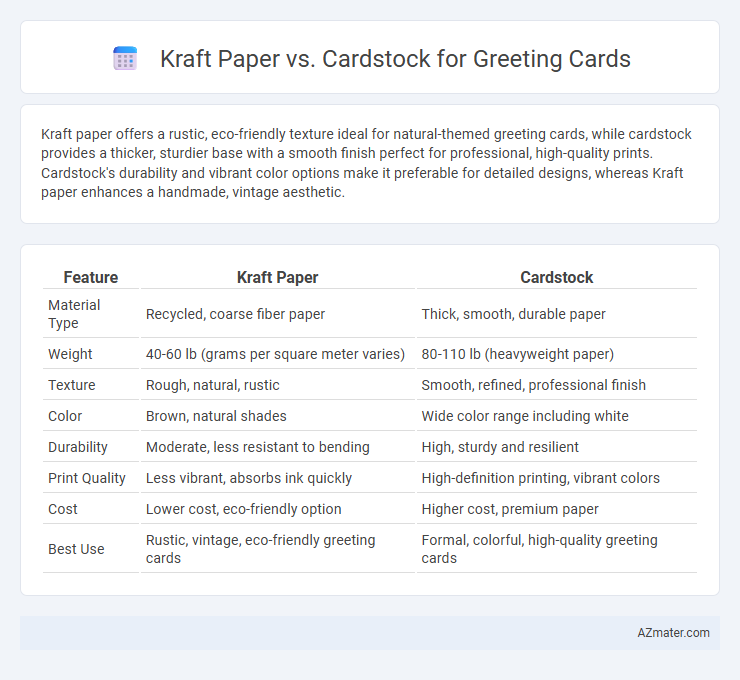Kraft paper offers a rustic, eco-friendly texture ideal for natural-themed greeting cards, while cardstock provides a thicker, sturdier base with a smooth finish perfect for professional, high-quality prints. Cardstock's durability and vibrant color options make it preferable for detailed designs, whereas Kraft paper enhances a handmade, vintage aesthetic.
Table of Comparison
| Feature | Kraft Paper | Cardstock |
|---|---|---|
| Material Type | Recycled, coarse fiber paper | Thick, smooth, durable paper |
| Weight | 40-60 lb (grams per square meter varies) | 80-110 lb (heavyweight paper) |
| Texture | Rough, natural, rustic | Smooth, refined, professional finish |
| Color | Brown, natural shades | Wide color range including white |
| Durability | Moderate, less resistant to bending | High, sturdy and resilient |
| Print Quality | Less vibrant, absorbs ink quickly | High-definition printing, vibrant colors |
| Cost | Lower cost, eco-friendly option | Higher cost, premium paper |
| Best Use | Rustic, vintage, eco-friendly greeting cards | Formal, colorful, high-quality greeting cards |
Introduction: Choosing the Right Paper for Greeting Cards
Kraft paper offers a rustic, natural texture perfect for eco-friendly and vintage-style greeting cards, providing durability and a unique tactile feel. Cardstock, known for its smooth surface and heavier weight, delivers a polished, professional appearance ideal for vibrant prints and detailed designs. Selecting the right paper depends on desired aesthetics, printing method, and card durability requirements.
Kraft Paper vs Cardstock: Overview
Kraft paper and cardstock serve distinct purposes in greeting card creation, with kraft paper known for its rustic, eco-friendly appearance and sturdy texture, making it ideal for earthy, handmade aesthetics. Cardstock offers a smoother surface and higher thickness, providing durability and a premium feel suitable for vibrant printing and intricate designs. Choosing between kraft paper and cardstock depends on the desired visual style and functional requirements of the greeting card project.
Aesthetic Appeal: Natural vs Polished Look
Kraft paper offers a rustic, natural aesthetic with its earthy brown tones and textured surface, appealing to those seeking an eco-friendly, handmade appearance for greeting cards. Cardstock provides a polished, smooth finish available in a variety of vibrant colors and weights, enhancing the card's professional and refined look. Choosing between kraft paper and cardstock depends on the desired visual impact, with kraft emphasizing organic warmth and cardstock delivering sleek sophistication.
Texture and Feel: Tactile Experience
Kraft paper offers a rougher, natural texture that provides a rustic and organic tactile experience, enhancing the handmade feel of greeting cards. Cardstock features a smoother, denser surface that feels sturdier and more polished, lending a professional and premium touch. The choice between Kraft paper and cardstock significantly impacts the sensory perception and overall impression of the greeting card.
Durability: Sturdiness and Longevity
Kraft paper offers moderate durability with a natural texture, making it sturdy enough for rustic greeting cards but less resistant to heavy handling over time. Cardstock provides superior sturdiness and longevity due to its thicker composition and smooth finish, ensuring the greeting card remains intact and vibrant through frequent use and storage. For long-lasting, durable greeting cards, cardstock is the preferred choice over kraft paper.
Print Quality: Color and Detail Reproduction
Kraft paper offers a natural, textured surface that enhances rustic or vintage greeting cards but may absorb inks unevenly, resulting in muted colors and less crisp detail reproduction. Cardstock provides a smoother, denser surface ideal for high-resolution printing, delivering vibrant colors and sharp, precise details crucial for intricate designs. For optimal print quality, cardstock outperforms Kraft paper in color fidelity and fine detail reproduction due to its superior surface uniformity and ink compatibility.
Eco-Friendliness: Sustainability Comparison
Kraft paper, made from unbleached wood pulp, offers a more sustainable option for greeting cards due to its minimal processing and biodegradability. Cardstock, while durable and versatile, often involves heavier bleaching and chemical treatments that increase its environmental impact. Choosing kraft paper supports eco-friendly practices by reducing chemical usage and promoting recycling and composting in card production.
Design Versatility: Customization Options
Kraft paper offers a rustic, natural texture ideal for eco-friendly and vintage-inspired greeting cards, with customization options including stamping, hand lettering, and natural dyeing. Cardstock provides a smooth, sturdy surface suitable for detailed printing, embossing, and die-cutting, allowing for a wide range of vibrant colors and finishes. Both materials support diverse design techniques, but cardstock excels in precision and color retention, while kraft paper emphasizes organic and tactile customization.
Cost Considerations: Price Comparison
Kraft paper generally offers a more cost-effective option for greeting cards, with prices significantly lower than cardstock due to its simpler manufacturing process and recycled content. Cardstock, known for its thickness and durability, tends to be more expensive but provides a premium feel and sturdier finish, which can justify the higher price for special occasions. Bulk purchasing of kraft paper can further reduce expenses, making it ideal for budget-conscious projects, while cardstock's consistent quality supports professional-grade card production despite its higher cost.
Best Uses for Kraft Paper and Cardstock in Greeting Cards
Kraft paper offers a rustic, natural texture ideal for eco-friendly or vintage-style greeting cards, providing durability and a unique brown-toned backdrop that enhances handwritten or stamped designs. Cardstock is thicker and smoother, perfect for vibrant prints, embossing, and layered embellishments, making it suitable for professional, high-quality greeting cards with a polished finish. Both materials can be chosen based on the desired aesthetic and structural needs, with kraft paper emphasizing organic appeal and cardstock delivering versatility and elegance.

Infographic: Kraft paper vs Cardstock for Greeting card
 azmater.com
azmater.com